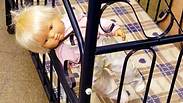
Israeli online program helps prevent bedwetting
Therapee combines an alarm and plastic sheet with sensors, cognitive behavioral therapy and positive reinforcement.
Tamar (not her real name), who lives in the town of Beit Shemesh halfway between Jerusalem and Tel Aviv, wet her bed until she was seven years old. Her mother took her to see Tal Sagie, one of Israel’s premier enuresis specialists, who, over a period of several months, helped Tamar solve the problem.
But several years later she regressed, and at age 11, her mother Sarah (not her real name either) decided to try Sagie’s online program called Therapee.
"The program was excellent. My daughter felt like she was meeting the therapist even though they were prerecorded meetings," Sarah told The Media Line. "She was enthusiastic about filling in the chart, and having the meetings online every two weeks. For me, I don’t live near the clinic so it was nice to be able to do it in my own home at my convenience."
Since completing the six-week program, Tamar has been dry except for one night during the recent fighting between Israel and Hamas in the Gaza Strip.
Bedwetting is far more common around the world than many people realize. Sagie says that at age four, one-quarter of children still experience enuresis. At the age of 6, there are still 15% of children having frequent "accidents," and even after age 18, between 1 and 2% of children are still frequently urinating in their beds. In the US, he says, five to seven million children suffer from the problem.
The condition is usually caused by a child sleeping so deeply that he or she does not wake up in time to make it to the bathroom. Sagie, who along with his father Jacob Sagie has seen more than 30,000 patients around the world since 1984, says that parents often make mistakes in trying to treat the condition.
"A lot of parents, for example, wake up their child during the night," Sagie told The Media Line. "They try to help them, but by doing that they’re taking all the responsibility from the child. They might also limit the child’s liquids or even punish him."
The vast majority of children are embarrassed by bedwetting and it can affect their self-esteem, as it did for Tamar.
"My daughter couldn’t go to sleepovers and she used to get teased because she wore a diaper," Sarah says. "Now she feels much better about herself."
The condition is often genetic, says Sagie, who himself used to wet the bed until he was eight and whose oldest son did as well. Medication has not proven effective and can have side effects. He invented a program that combines an alarm and plastic sheet with sensors, with cognitive behavioral therapy (CBT), and positive reinforcement.
The alarm is not connected to the child’s body but sits on a chair or desk nearby, as well as a sensor pad that is placed under the sheet. At the first sign of wetness, the alarm goes off, and the parent has to make sure the child wakes up and goes to the bathroom.
Eventually, says Sagie, the child makes a subconscious connection between bedwetting and having to get up in the middle of the night, and the bedwetting ends.
However, the alarm and sensor pad alone are not enough to ensure that the bedwetting stops. Monitoring by a trained therapist and feedback for the child are essential for the treatment to work, says Sagie.
In the US, Sagie sees patients for the first time in person and then follows up with sessions by Skype. However, in the new online program called Therapee, Sagie prerecords videos that are meant to respond to an online chart filled out by the child and parent together that keeps track of the number of bedwetting incidents and what time they occurred.
"We basically took every possible scenario in this program and we prerecorded it," Sagie said. "There are hundreds of different scenarios and a very sophisticated algorithm that runs in the background of the software. It knows how to analyze the child’s condition and based on this analysis decides what will be the next step."
The treatment is meant to be interactive, with a recorded video of Sagie asking the children questions and having them click on the answers. They get virtual "stars" on the chart for having days without accidents, as well as encouraging messages from Sagie.
This traditional program can cost thousands of dollars in the US, where Sagie sees several hundred patients a year, and where it is not covered by insurance. In Israel, where most of the treatment is covered, it still costs several hundred dollars. Therapee, the online program, costs an average of $250.
Currently available only in English, the program is being translated into Spanish, Hebrew, Japanese and Arabic. It is already being shipped all over the world, including to Dubai in the United Arab Emirates.
Sagie says the buyer did not seem to care that the product was from Israel, but because there are no diplomatic relations between Israel and the UAE, he shipped it to an address in Europe.
He says that translating the program into different languages will enable Therapee to potentially reach millions of people.
Article written by Linda Gradstein.
Reprinted with permission from The Media Line.










